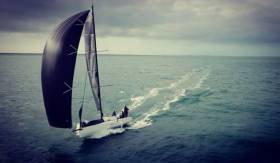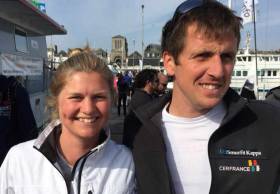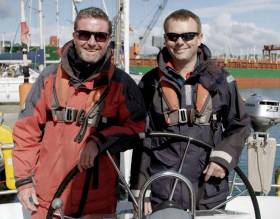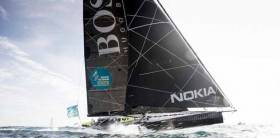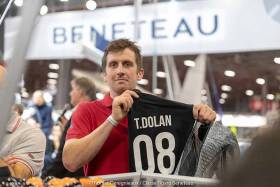Displaying items by tag: Tom Dolan
Tom Dolan & Damian Foxall Thirteenth in Sardinha Cup First Leg
Irish offshore sailors Tom Dolan and Damian Foxall finished 13th in the new foil-assisted Figaro Bénéteau 3 in the first leg of the Sardinha Cup, France this morning. A second Irish team, Atlantic Youth Trust, skippered by Joan Mulloy and Mike Golding were 32nd in the “Warm Up” Leg of the Sardinha Cup which is part of the 2019 French Championship for Offshore Sailing.
The next leg starts of Tuesday 2 April 2019 with a 600-mile race from St Gilles Croix de Vie to the UK and back.
See the full leg one results here.
The Irish duo had lead off the start line and remained very much in the match, in the leading group for most of the stage, succumbing to one small error on what proved to be the final leg in to Saint Gilles Croix de Vie, the start and finish port.
Dolan reported:
"We are happy with our place and happy with our speed too. We made a small mistake on the long tack between the Ile de Yeu and Les Sables d'Olonne by going a little too close to the coast. We were hoping to get more pressure than the others, but in the end, we lost a lot of places, "explained the skipper of Smurfit Kappa.
"We were in the game for the whole race. As Damian said, we arrived in good company. It's definitely fun to play in the best group, "added the Irish sailor, who reflected on their glamour start: "It was really nice to pass in front of the whole fleet. What I will remember though is that we really have good speed and so we can play a low-risk strategy and look to make small gains here and there." The duo heart from finishing in front of some big names such as Loïck Peyron, Gildas Morvan, Xavier Macaire, Gwénolé Gahinet and Charlie Dalin. "It gives you confidence for the future," Dolan summarised.
Looking ahead to the send stage, Act 2 which starts on Tuesday, Tom said: "We will try to rest and work hard on our navigation and strategy homework as the next stage is longer and carries a three times coefficient. So we would love to do well and feel we can as we have decent speed."
The double-handed series of offshore races comprises a first 147 nautical miles 24 hours opening stage which starts on Saturday, followed by two longer stages of up to 650 miles, starting on 2nd and then the 9th April, each starting and finishing from Saint Gilles Croix de Ville on the French Vendée coast, a town well known for their sardines, hence the inaugural race series’ name.
Dolan, 31, from Kells, County Meath finished third rookie in his first season in the Figaro class but as the fleet adopts the new Figaro Bénéteau 3, he has chosen to draw on the experience of his compatriot co-skipper 10 times round the world racer Foxall, 50, from County Kerry on what promises to be a steep learning curve for all the sailors as they adapt to the new design.
Although the new boat is equipped with foils there seems to be little chance to benefit from them on the first stage, a triangle course formed by passing Ile de Yeu off Les Sables d’Olonne passed on the outwards and the return passage from a buoy Banc de Guérande lying to the west of the entrance to the Loire river at Nantes. Only very light winds are expected and although the name of the opening stage is the ‘Vendée Warm-Up’ the nights will still be long and chilly. Among the 68 sailors on the 34 boats are Volvo Ocean Race winner Charles Caudrelier, Route du Rhum winner Loick Peyron, and two three times winners of La Solitaire du Figaro, Yann Eliès and Jérémie Beyou. But as there has been no racing at all for the new boat, except for informal practice among the training groups, there is no form book.
Foxall explains, “There is a great mix of sailors in the field, some like Erwan Tabarly who joined the class in my last year has done 19 La solitaires in the last 20 years, and Loick Peyron is back, then there are a lot of very, very good singlehanded Figaro sailors, this really is the best of the best. But out of the 34 teams racing there are at least 20 which could win. It is amazing.”
“We feel good, we could all have done more and you can never have done enough,” Dolan confirms, “There is always something more to do, but in that respect, I think we are all in the same position. At the end of the day we have had more sailing than some of the other boats and we have had a couple of good solid weeks working on the boat too.”
The format of the races, long offshore stages with little rest between them, are designed to mirror that of La Solitaire du Figaro URGO, the season’s pinnacle solo event which takes place in June.
Foxall says, “It really is like a mini Solitaire, double-handed. The nights will be longer and colder and it will potentially be windier at some points. But it is a very similar format, short, hard legs where you don’t get a lot of rest, some crucial moments when you have to be absolutely on the ball, going fast and in the right direction, and you have to be doing that three times over the next three weeks. It is a really nice format. It is a really nice way to start with the new boat.”
The duo will rely on their experience to support each other, ensuring Smurfit Kappa is going fast in the right direction, Foxall, who won the two-handed Barcelona Race round the world, explains how they plan to work together on board, “I think it will happen naturally as it does in double-handed sailing. Sailing the boat fast in the right direction is a two-person operation with someone driving and looking after the performance of the boat and the other is maybe looking more out of the boat at strategy and tactics, and making sure the trim of the boat is right, and then when the odd occasion allows some rest we will try and do that.
Because of the very light winds forecast for today on France's Vendée coast, Sunday, Race Direction of the Sardinha Cup made the decision early this morning to shorten course for the opening stage of the three leg race series which is the first test for the new Beneteau Figaro 3 class.
Tom Dolan will form an all-Irish partnership with the vastly experienced Damian Foxall for the first race for the new Figaro Beneteau 3, the Sardinha Cup which starts on March 27th.
After last year’s promising first season in the Figaro one design class, finishing third rookie overall, Dolan has embraced the circuit’s change to the brand new foiling Figaro Beneteau 3, and has spent recent weeks learning how to make the new boat sail fast.
Ten times round the world sailor, a winner of the crewed Volvo Ocean Race and the two-handed Barcelona World Race round the world, Foxall cut his teeth in the solo and short-handed world in the Figaro class in the late 1990s and early 2000s. He became was the first even non-French skipper to win a leg of La Solitaire du Figaro and who finished top rookie in 1997.
The decision to move to the new foil-assisted, faster and more responsive Figaro 3 has proven a magnet to many of the top French ocean racing stars such as Loick Peyron, Michel Desjoyeaux, and Charles Caudrelier as well as three times La Solitaire winners Jérémie Beyou and Yann Eliès.
Dolan received his new Figaro 3 on January 25th and had his first training sessions in February coached by Tanguy Leglatin and Gildas Mahe. “To be honest the training has been going very well.” Said Dolan, who hails from Kells in County Meath but lives in Concarneau.
“We have been among the fastest boats on the water. But like everyone we need to work hard on the manoeuvres. That is where the biggest losses are right now.”
Dolan adds: “It is great to have Damian with me. He is very calm on the boat and his experience is obvious but one of the most important learnings for me has been organisation, discipline and attention to detail, how to run a programme. He has been giving me a bit of a push in that direction and it makes a real difference in terms of confidence in yourself and the programme.”
“But besides all that, we have a good craic together and I have long since forgiven Damian for his County Kerry roots.”
Foxall is delighted to be back in France among many of his Figaro counterparts, French sailors who have remained friends and rivals over the 20 years, and loving the challenge of scaling the Figaro 3 learning curve as fast and efficiently as possible with his fellow countryman Dolan.
“Being on the dock here in Lorient it feels like only yesterday when I was here in my Figaro years. It is fantastic. There is the same kind of sensation with some of the best offshore racers in the world here. It is a fantastic opportunity for us to showcase Irish sailing.” Foxall smiles.
“Tom has been here in France and doing it for a few years and he is well integrated with the sailors here and he is doing well. Here we have top guys like Charles Caudrelier and Alain Gautier and we are holding our place at the top of the fleet.”
Solitaire Du Figaro Returns To Ireland This Summer In 50th Gala Edition
Following last year’s performance of ‘Flying Irishman’ Tom Dolan and pioneering woman Joan Mulloy in their Solitaire du Figaro debuts, now the renowned solo offshore race is coming to Ireland.
The Solitaire URGO Le Figaro is set to return to Kinsale this summer for the first time since 2009 for its 50th gala edition, with a course that takes in a rounding of Fastnet Rock to Kinsale on the weekend of 8-9 June to end its first leg out of Nantes.
The racing fleet continues on a “marathon run” around the Irish coast through the Irish Sea, around the Isle of Man and back down the west coast of Great Britain to Roscoff in northern France.
Stage three is a loop of ‘La Manche’ back to Roscoff before the final stage, via Wolf Rock and the Isle of Wight, to Dieppe. In all the course covers 2,130 miles (not accounting for weather-related changes).
Tom Dolan has already pledged his return for his second Figaro, this time in his new Figaro 3 boat, while the presence of Joan Mulloy — Ireland’s first female entry in the race — will further buoy Irish interest in the challenge as it takes in our coast.
Dolan tells Afloat.ie that he is “itching to get going after three months of computers and meetings!”
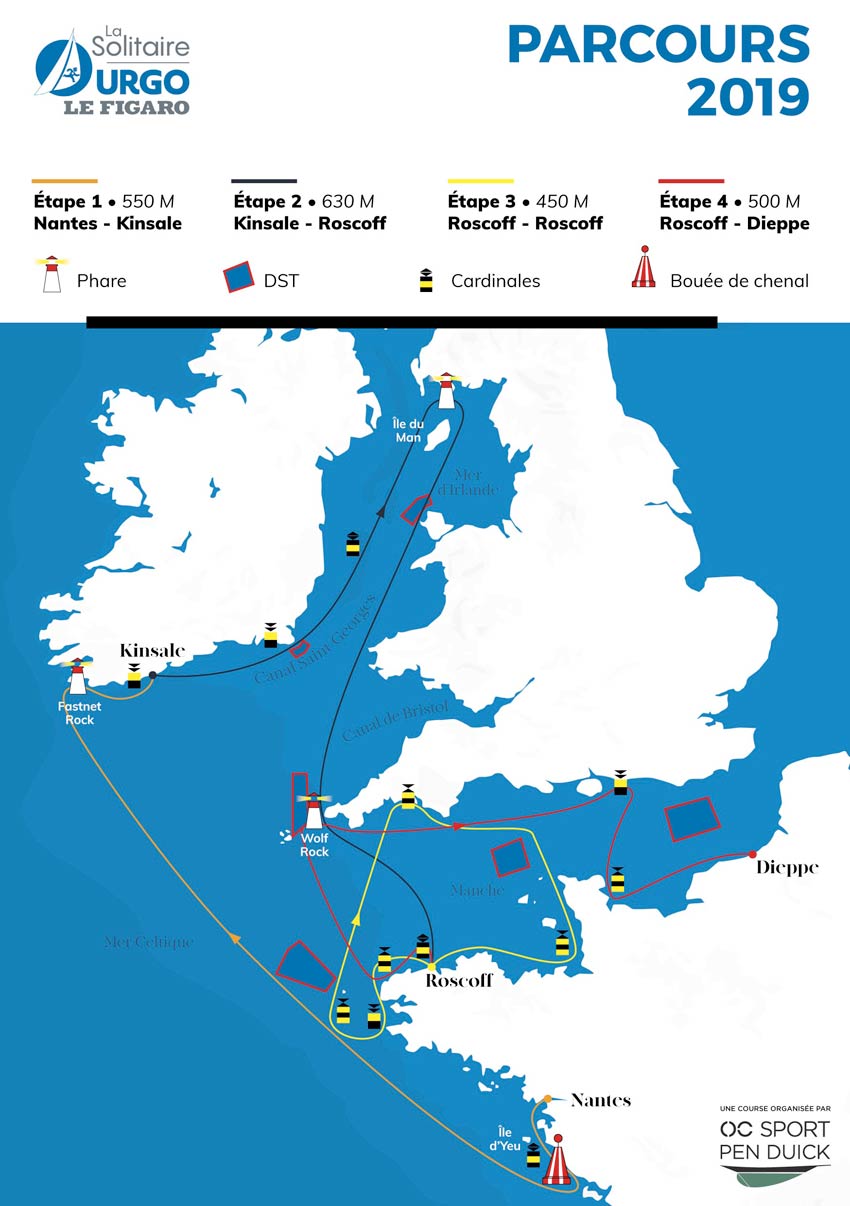
Race organisers add:
The Solitaire URGO Le Figaro is set to enter a new era this year, with the introduction of the new Figaro Bénéteau 3 for the 50th edition of the annual solo sailing race. Starting from the French city of Nantes on June 2nd, 2,130 nautical miles of challenging offshore racing around some of Europe’s roughest waters await the Figaro skippers, including a return to Ireland with a stopover in Kinsale.
Owned and organised by OC Sport’s French subsidiary OC Sport Penduick, the Solitaire URGO Le Figaro is one of the world’s toughest sailing competitions. Fiercely competitive, the race is recognised as the unofficial world championship of solo offshore racing, with the course taking just over a month to complete. Requiring a unique skill set, the Solitaire URGO Le Figaro pushes competitors to the edges of their physical and mental limits.
OC Sport Pen Duick Event Director Mathieu Sarrot commented: “This anniversary year of the Solitaire is set to be an historic edition and we are expecting a diverse fleet including previous winners and new comers to the new Figaro Bénéteau 3. This means the stakes will be high with everyone out to prove themselves in a new boat.
“On the water it will be particularly challenging,” Sarrot continued. “To be successful the competitors will need seasoned offshore experience as well as coastal knowledge. But also sheer grit and determination. With the ongoing support of our title partner URGO, it’s set to be an incredible 50th edition."
The fleet will start leg 1 under the striking bridge of Saint-Nazaire following a passage through the river Loire from the historic city of Nantes in Brittany. After rounding Île d’ Yeu, they will head across the Celtic Sea before passing the legendary Fastnet Rock and heading to the port of Kinsale, Ireland. At 500 nautical miles, the fleet will be immersed in a tough race from the off with a drag race through potentially choppy seas to keep the solo skippers on their toes before they arrive in Irish waters.
Speaking on behalf of the Kinsale Chamber of Tourism and Business, Board Member Ciaran Fitzgerald and Chairperson Guny Patel commented: “Kinsale Chamber is delighted with the announcement that the 50th Anniversary of the prestigious La Solitaire Le Figaro yacht race has been awarded to Kinsale for June 2019.
“This is an amazing event for Kinsale to host and welcome back having hosted this world famous single handed race more than any Port over the 50 years of the race. Kinsale Chamber looks forward to welcoming the sailors and visitors for what will be an incredible spectacle on sea and land over the five days of the stopover. Congratulation to Enda O'Coineen and his team for bringing this event to Ireland.”
Expected to arrive in Kinsale on Wednesday 5th June, the Solitaire URGO Le Figaro fleet will stay in Ireland until Sunday 9th June, when the skippers will set sail on the longest 630-nautical mile Leg 2 to Roscoff in northern Brittany. In a first for the Figaro fleet, this marathon stage will take the skippers along the stunning Irish coast and through the unpredictable, and at times dangerous, Irish sea before rounding the Isle of Man. A long descent along the rugged western Welsh coast, followed by a passage between Land's End and the Scilly Isles, before a crossing of the English Channel towards Roscoff will conclude what is sure to be a gruelling leg.
From Roscoff, the fleet will stay in the familiar waters of Brittany where they will tackle a 450 nautical mile coastal course that will require them to use all of their technical and tactical prowess in the strong tidal currents, before returning to Roscoff on Wednesday 19th June.
To end the 2019 Solitaire URGO Le Figaro, the increasingly exhausted fleet have a double Channel crossing to contend with. At 500 nautical miles, the final leg will see the competitors leave Roscoff on Saturday 22nd June to head across the channel towards Land’s End via a starboard rounding of the south cardinal navigation mark off Portsall. From there, they will have to negotiate the difficult conditions along the south coast of England before skirting the Isle of Wight, and crossing back into French waters through one of the world’s busiest shipping lanes. With fast depleting energy, the skippers will need to keep their wits about them as they head to a mark off Barfleur, before the final sprint into the Normandy fishing port of Dieppe.
The skippers are expected to arrive in Dieppe on Wednesday 26th June, with a non-points scoring postlogue race planned for Saturday 29th June allowing the public to see the new Figaro Bénéteau 3’s in action before the official prize giving where the winner of the 2019 Solitaire URGO Le Figaro will be crowned.
As many as 40 Figaro skippers are expected to compete in this 50th anniversary edition, including former winners alongside a plethora of young talent. At 2,130 nm, the 2019 Solitaire URGO Le Figaro course is one of the longest in race history and it will take everything in the skippers’ solo offshore arsenal to get them to the finish line.
With just over five months to go until the build-up begins in Nantes, the skippers will be using this valuable time to take delivery and train on their new Figaro Bénéteau 3’s. A full skippers line-up will be revealed in April.
La Solitaire URGO Le Figaro 2019 Schedule
May 27th: Arrival of the fleet in Nantes, France
June 2nd, Leg 1 start: Nantes, France – Kinsale, Ireland (via Fastnet Rock) – 500nm
June 9th, Leg 2 start: Kinsale, Ireland – Roscoff, France (via the Isle of Man) – 360nm
June 16th, Leg 3 start: Roscoff, France – Roscoff, France - 450nm
June 22nd, Leg 4 start: Roscoff, France – Dieppe, France – 460nm
June 26th: Anticipated arrival of first boats in Dieppe
June 29th: Postlogue and awards ceremony in Dieppe
Tom Dolan Set For Brunch Talk At The Royal St George This Saturday
‘Flying Irishman’ Tom Dolan will join Royal St George Yacht Club members for brunch at the Dun Laoghaire waterfront clubhouse from noon this Saturday 19 January.
Tom was nominated for Irish Sailor of the Year 2017 and again in 2018, and his adventures feature prominently in the 2019 Afloat Irish Sailing Annual.
The France-based Irish sailing professional has been nicknamed ‘l’irlandais volant — or ‘the Flying Irishman’ — for his accomplishments in the challenging solo offshore Figaro race.
Tom will tell RStGYC members about his intense 2018 season which culminated in the Solitaire du Figaro, a story illustrated with slides and videos that he’s already brought around Ireland.
He will also elaborate on his plans for this year’s race with his new boat, the revolutionary foiling Beneteau Figaro 3, which he previously revealed in a talk at Poolbeg Yacht & Boat Cub earlier this month.
The offshore sailor’s visit comes after a welcome talk by Annalise Murphy last week, and should be of interest to sailors young and old alike.
The talk starts at noon sharp, with the usual George Brunch available from 11am to 2.30pm. There is no extra cost for the talk. To book call Laura in Reception at 01 280 1811.
Sailing into Wellness at Poolbeg Yacht & Boat Club: Talk By Tom Dolan, James Lyons & Colin Healy
On Thursday 10th of January County Meath solo sailor Tom Dolan will be giving a short presentation on his 2019 racing season in support of the social enterprise 'Sailing into Wellness'
Sailing into Wellness is an award winning not for profit social enterprise, who exist to help people in their recovery from poor mental health and addiction in Ireland. Its co-founders, Colin Healy and James Lyons, will speak before Tom about how their sailing programme helps people in their recovery from poor mental health and addiction.
By focusing on a natural and healthy approach to improving mental health and well-being they have developed a sailing program that is both education and therapeutic. Now in their third year of operation SIW work with community organisations nationwide and run sailing activities on the East and South coast. It is their vision for Sailing Into Wellness to be an integral part of the fabric for recovery in Ireland.
Colin Healy is an expert by experience. During his personal battle with addiction and depression, he found sailing to have a substantial therapeutic value. James Lyons is one of Ireland’s most experienced sail training professionals, he has been safely teaching and guiding new sailors along Ireland’s Atlantic coast for 20 years
Tom Dolan’s intense 2018 season, competing over an 8,000 mile racing circuit, culminated in the Solitaire du Figaro. This racing competition is widely considered as the highest level there is in singlehanded offshore sailing. Despite being his first Figaro season, Tom was on the podium in December at the Paris International Boat Show for his third place award in the Rookie section. Tom is here to tell us how it went, warts and all, and illustrating it with his revealing videos. 2018 had it all: Strong winds, intense moments, big waves and big upsets He will also reveal his plan for the Solitaire du Figaro 2019 with his new boat, the revolutionary Beneteau Figaro 3, and his longer term dreams. These include racing round the world and representing Ireland in the 2024 Olympics.
Tom’s success as a competitive solo sailor hasn’t blinded him to his Glenans training based on a love of the sea and the power of teamwork on a sailing boat to bring about the best in everybody. Hence his desire to support the work of Sailing into Wellness.
The show starts at 2000 at Ringsend Yacht & Boat Club. €5 entry in support of Sailing Into Wellness. All are welcome
Are Today’s Boats Getting in the Way of Sailing’s Popularity?
The sailing community’s notable diversity is dependent on how you’re trying to analyse it writes W M Nixon. For many, it’s the community aspect, the shared love of boats and sailing and interacting with sea or lake, which is the sport’s greatest appeal. But for others, the greatest attraction is because it’s a competitive vehicle sport.
In fact, it could be argued that a useful indicator of where you fit into the complex sailing world is your place along the boats-to-people continuum. At one extreme, there are those for whom the boat and her equipment is everything. And at the other end of this boats-to-people line, there are those for whom the successful interaction of the crew, the people management side, is paramount – organising the boat and dealing with her technical problems is something for specialized members of the team.
Not so long ago, while cruising the Hebrides, we met up with one of the purest boat nuts I’ve ever encountered, even if he did offset this tendency by using his superbly-maintained boat for very interesting projects.
We liked the look of his 34ft cutter, and as we were in a sublimely beautiful anchorage where no-one was in a hurry to move on in the morning, we inveigled an invitation aboard and were bowled over by the quality of everything on his boat, the maintenance, and the careful way it had been thought through to make his cruising as comfortable and practical as possible.
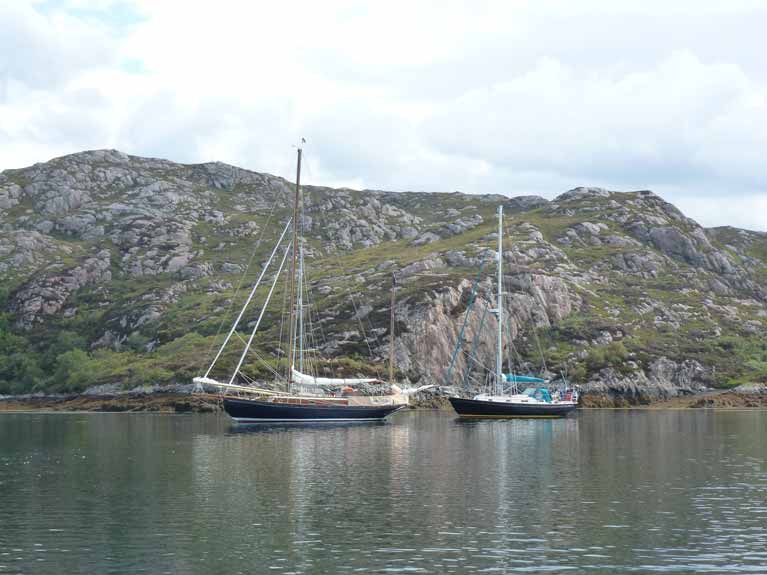 “ Sailing” as its cruising participants like it – an idyllic summer morning in the Hebrides for the veteran Ainmara (left) and the superbly organised Victoria 34 cutter Sula. Photo: W M Nixon
“ Sailing” as its cruising participants like it – an idyllic summer morning in the Hebrides for the veteran Ainmara (left) and the superbly organised Victoria 34 cutter Sula. Photo: W M Nixon
For instance, he’d re-wired the boat completely by himself, and had done it in such a way that although everything seemed invisible and skilfully done, the simple opening of accessible locker doors in key areas revealed all the parts that needed to be easily reached.
It was a pure case of single-minded perfection, so much so that we were thinking of ways to entice him to Ireland some time to give our own boats the same treatment. But in his case, “single-minded” was the essence of it all. He’d once sailed alone in a Wayfarer from Scotland across the North Sea to Norway, but few knew of it because he did it for his own satisfaction – publicity wasn’t of interest to him.
And now, after we’d had coffee together, he was off across to Skye to climb in the Cuillins. On his own, of course, and using that perfect solo-sailed boat as a handy base camp. This was indeed a man who marched to the beat of a different drum. For our part, we were nipping across to Plockton on Loch Carron, a notably convivial place, to continue a cruise of sociable celebrations.
As far as we were concerned, this was cruising as it should be, and cruising lends itself to accommodating every level of direct or indirect boat technical involvement. However, cruising is a world in itself. But in racing, the fact of sailing being a vehicle sport immediately puts a wall between it and most other sports, particularly those stadium sports of greatest public interest.
 Is this sailing’s Formula 1? The America’s Cup boats of 2013 were foiling multihulls
Is this sailing’s Formula 1? The America’s Cup boats of 2013 were foiling multihulls
 The America’s Cup rings the changes – and whatever they are, they’re always expensive. The next series in New Zealand will be raced in 75ft foiling mono-hulls
The America’s Cup rings the changes – and whatever they are, they’re always expensive. The next series in New Zealand will be raced in 75ft foiling mono-hulls
So in trying to increase sailing’s public awareness, we quickly find people referencing Formula 1 car racing, and claiming that sailing will only find universal appeal if its major events are staged in the most spectacular boats available.
Certainly, this has long been the way of the America’s Cup. But that’s quite obviously a sailing spectacular for people to stare at in wonderment, rather than expect any sense or possibility of personal involvement.
However, the Olympics are different. Olympic sailing is arguably the kind of sailing we can do at club level but carried to the ultimate extremes of personal high performance. But is that necessarily the way that sailing should go? In a tech-obsessed era - a state we’ve arguably lived in since man chipped his first flint axe-head – there are those who would argue that the boats used in the Olympics should be at the furthest edge of technological development.
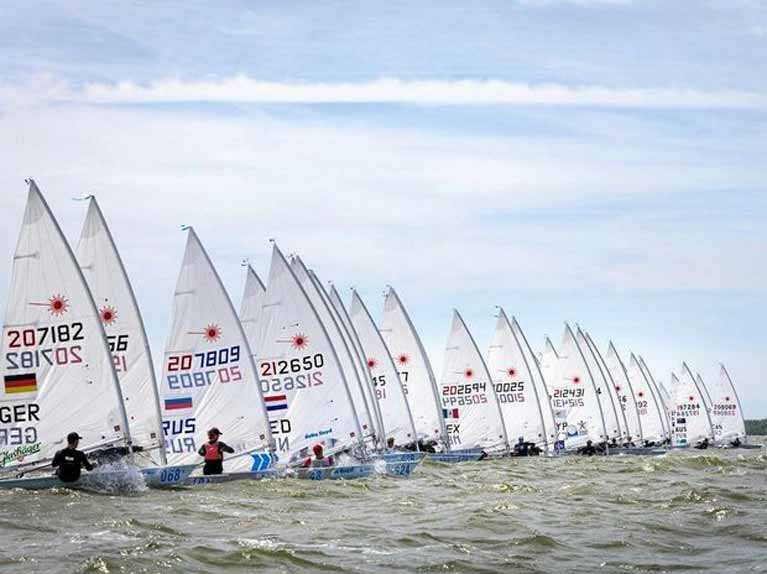 For club sailors, the fact that their popular Laser is an Olympic Class is seen as a bonus. But for the casual viewing public, could it possibly be that a large fleet of Lasers is not the most exciting or comprehensible sporting vista in the world?
For club sailors, the fact that their popular Laser is an Olympic Class is seen as a bonus. But for the casual viewing public, could it possibly be that a large fleet of Lasers is not the most exciting or comprehensible sporting vista in the world?
This is their point in arguing that today’s boats are getting in the way of developing sailing’s popularity. In a sense, they argue that by using popular everyday boats for a television spectacular like the Olympics, the powers-that-be are making the images decidedly humdrum for an audience steeped in technological wizardry.
It’s an approach which came to a head a month ago when, thanks to the remarkably high Irish representation in the committees of World Sailing – a priceless inheritance from the determinedly internationalist days of Dun Laoghaire’s Ken Ryan – we were among the first to be able to report the confirmation about the inclusion of an offshore racer (to be crewed by a woman and a man) in the lineup for the 2024 Olympics at Paris, when the sailing will be at Marseille.
The boat proposed will be between 6 and 10 metres overall, and non-foiling. With the course planned to have them at sea for three days and two nights, it will be the longest event in the Olympics, and all boats will be connected for sound and vision 24/7, so the human interest levels should be very high indeed.
 Tom Dolan with his Figaro 2 Smurfit-Kappa. This highly-regarded 2002 Marc Lombard design is now categorized by the builders as a “Heritage Boat”
Tom Dolan with his Figaro 2 Smurfit-Kappa. This highly-regarded 2002 Marc Lombard design is now categorized by the builders as a “Heritage Boat”
This confirmation (at last) marked such a change to the Olympic sailing format that it provoked a considerable immediate reaction. But working on the policy that second thoughts are often best and usually less harmful, we persuaded some of our more outspoken reactors to tone it down a little with the promise that we’d keep them anonymous for the time being, and would publish after a reasonable interval.
However, now we’re in the buildup to Christmas when true sailors rely on the thought of the Rolex Sydney-Hobart Race to preserve their sanity in the midst of smothering seasonal cheer. So here’s something else altogether - shot from both barrels - to provide something similar:
“I am no doubtless connected with the ‘higher governance level’ of our beloved sport than yourself or others, but the ‘design’ brief of the intended boat for Paris 2024 Offshore event (quote:“…..boat which will be used, the length overall will be between 6 metres and 10 metres, definitely non-foiling, and currently talked of as sloop rig with spinnaker…”) shows, yet again, how out of touch World Sailing is with its own sport!
The IMOCA 60 Class is progressively shifting to foil (see Route du Rhum 2018) and the Mini 6.50 class rules now allow foils, wingsails and even kites, while the new America’s Cup boat won’t even have a keel but 2 foils (etc etc…there are many other examples). Thus the notion that ‘what the public wants to see in the Olympics are non-foiling monohulls of 6 to 10m LOA’ baffles me!!!
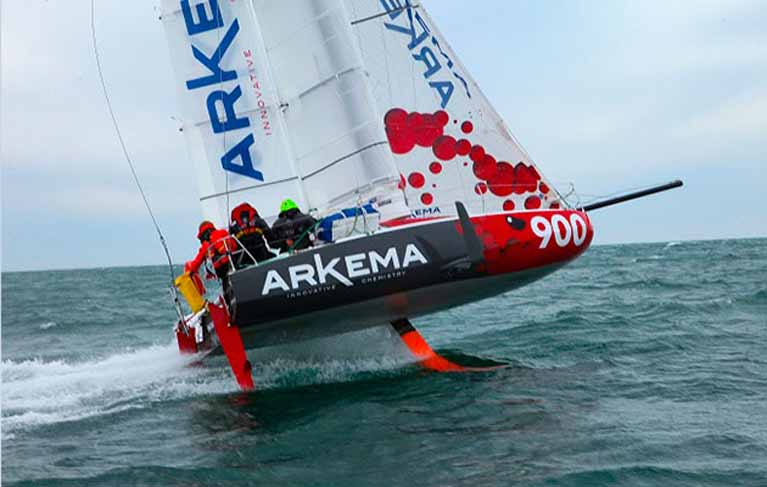 The Mini 6.50 class now permits foils, and even with three on board, the little boat lifts and flies
The Mini 6.50 class now permits foils, and even with three on board, the little boat lifts and flies
Paris won the 2024 Olympic Games. Sailing is one of the Olympic Sports. Olympic Sailing attracts very little spectators and/or much less TV audience than the ‘professionally organised circuits’ (Minis, Figaros, IMOCAs, big multihulls, Route du Rhum, Vendee Globe etc etc…).
The aim is to change this and for once, France as the organiser and for all sailing nations, may stand a chance to make some Olympic sailing look sexy! And as you mention, there already had been an attempt – scheduled for June 2018 – to preview a potential Olympic offshore race
Nicolas Hénard, President of the Federation Francaise de Voile, declared:
« …We are the nation of offshore sailing, we can’t afford to miss this (opportunity). This is why I am doing the forcing on this with the organisation of a showcase event in Marseilles in June (2018) in parallel with the finals of the Worlds Cup with five Figaro 3 on loan from Beneteau…”
Unfortunately, due to funding issues, this demo event was cancelled…but of course the demo support was the Figaro 3.
Staging a new Olympic discipline in 2024 on a boat that, though not yet selected, is already outdated in 2018 for the intended purpose is ludicrous.
This is even more so for the Figaro 2 as the article suggests, a boat launched in 2002 and classified on the Beneteau website itself under the heading ‘Heritage”
Also, my understanding is that, for an Olympic sailing event, boats have to be supplied (I guess new?!) by the organisers…hardly Figaro 2s then…
The reality is that:
• The Figaro Class and Circuit is the ‘only game in town’ worldwide for an ‘affordable’ (€210k ex. VAT including sails, electronics and safety equipment), one-design, short-handed, offshore racing class
• The Figaro Class is moving to foiling from 2019 onwards with the F3 because this is:
◦ What the competitors (read athletes for the Olympics) want!
◦ What the sport, as an offshore discipline, is at…right now, let alone in 2024
◦ What the viewing public demands
 It could be argued that the foiling Figaro 3 is no longer an extreme concept, and by 2024 it may even seem a little dated
It could be argued that the foiling Figaro 3 is no longer an extreme concept, and by 2024 it may even seem a little dated
The current ’design brief’ of the World Sailing Equipment Committee for the new proposed event in Marseilles 2024 can only be explained by either
- A complete misunderstanding of the sport (really?) or
- Anything BUT a Beneteau Figaro 3 attitude resulting from pressure/lobbying from other National Sailing Federations or other boat manufacturers who do not have an ‘affordable’ one-design offshore sailing boat in production or even in draft (J Composite?) in an attempt to ‘not give an unfair advantage to French Figaro sailors starting on this support from March 2019!
- If there are doubts that a new boat like the Figaro 3 will be available in sufficient number, FYI, Beneteau is rolling out one new Figaro 3 per week as we speak! That’s further good news, So the question for World Sailing is:
- Do we specify the boat that’s required and expected (FYI, I do not have any interest whatsoever in Beneteau ?)?
- Do we specify another one for political reasons and launch a new discipline in 2024 on an outdated support?
As for my ‘dream team’: Tom Dolan (French offshore circuit ‘veteran’, inc. Figaro circuit) and Annalise Murphy (3 Olympic campaigns by 2020, Moth sailor, Volvo Ocean Race veteran etc, would bring this event very much alive if they were racing a Figaro 3, or perhaps even its 2024 development.”
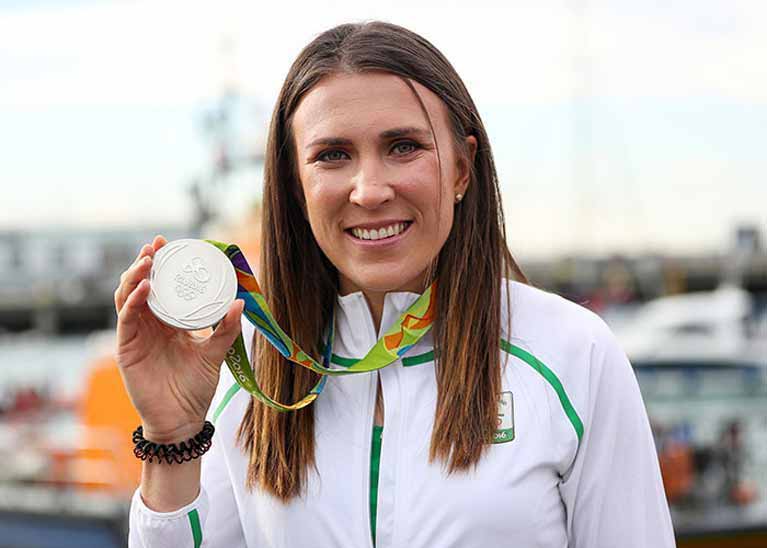
 Dream team – Olympic Medallist Annalise Murphy and Figaro veteran Tom Dolan
Dream team – Olympic Medallist Annalise Murphy and Figaro veteran Tom Dolan
Well, that’s telling it like it is – or might be. Instead of trying to minimise Olympic sailing’s vehicle sport aspect (which the 49er turns on its head anyway), World Sailing and the Paris/Marseille Olympics should go hell for leather for the most technologically-advanced yet economically-feasible boat possible.
It’s quite a challenge in itself. And if it seems a very long way from our agreeable meanderings about a perfect little cruising boat met with in the Hebrides, well, that’s the way it is – sailing is a very complex sport however you look at it.
2019 will be a year which will mark the 50th anniversary of the Figaro class, a class now recognised as the top level that there is in offshore sailing. And as Afloat.ie has been reporting from the Paris Boat Show, it's an exciting time for Irish involvement too.
The golden anniversary will be marked by an updating of the boat and following 15 years in service, the Beneteau Figaro 2 will be replaced by the super modern foiling Figaro 3. This levelling of the playing field has attracted almost many of the biggest names in sailing such as Frank Cammas, Michel Desjoyeaux, Armel Le cléac'h and Loïck Peyron.
To guarantee sporting equality each skipper was attributed their boat by drawing numbers out of a bowl during a lottery draw which turned out to be quite a glamorous occasion. Tom Dolan, along with Joan Mulloy, were supported with an Irish contingent which included Jack Roy, president of Irish Sailing.
Olympics in sight
"I bagged number 8 which is good, the Chinese say it’s a lucky one" the young Meath man grinned. "now it's time to get to work and find the necessary finance for the next few years. It's great to be able to start fresh with a new boat against the biggest names in the sport, but as you can imagine it's a big financial investment which means borrowing the price of a fine house over a number of years, but it's like any business, you won't get far unless you take the odd risk. Right now I need to find 80K"
Dolan also talked about his future. “For now I really want to concentrate on the Figaro class for a number of years and arrive at a point where I can perform consistently alongside the best as I did during phases this year. This is key in preparing for a spot on the Irish boat in the 2024 Olympic Offshore Event, there is no better school.”
Read also: How Will an Irish Olympic Two-Person Offshore Campaign for France 2024 take shape?
Ireland’s Tom Dolan on the Podium at the Paris International Boat Show
Tom Dolan of Ireland had his hectic first year on the Figaro circuit during 2018 celebrated at the Paris International Boat Show over the weekend when he was on the podium for the National Championship Offshore awards writes W M Nixon.
The Meath man took third overall in the rookie division following his success in the Two-handed Transatlantic Race at the beginning of the season, and then in the Figaro series itself in September, he was well up the rankings overall with his boat Smurfit-Kappa, despite having to pull out of the first leg after a rigging spreader became detached. Once back in the race for the next three stages, he showed some very promising bursts of speed, and was at his best in the difficult stage from Portosin in Northwest Spain across the Bay of Biscay to St Gilles.
Among those in Paris in support of his achievement in being the first Irish sailor to make this particular podium was Irish Sailing President Jack Roy.
Tom Dolan Brings His Talk To National Yacht Club
Tom Dolan’s series of talks on his remarkable 2018 offshore season continues in Dublin at the National Yacht Club tomorrow evening, Tuesday 27 November.
Last week the Figaro debutante regaled the members of the Royal Cork in Crosshaven with tales of his adventures, including his performance in the Transat AG2R.
Tomorrow night promises more of the same, plus valuable insights into the world of offshore sailing.
Supper is served from 7.30pm with the talk proper from 9pm. For supper reservations call Tim or Louise at 01 2805725 or email [email protected] or [email protected].
Tom Dolan To Talk Transat & Figaro Adventures In Cork & Dublin
The first in a series of talks delivered by offshore yachtsman Tom Dolan will take place at the Royal Cork Yacht Club on Tuesday 20 November.
Tom — who is in the running for 2018 Irish Sailor of the Year — will review the highlights of his 2018 season, including his performance in the Transat AG2R and his first participation in the challenging Figaro du Solitaire, and outline his plans for 2019 and beyond.
The versatile skipper promises video clips from this year’s racing season combined with plenty of weather and sailing tips.
And he will also try to give some helpful insights into the world of offshore sailing, with the aim of helping younger or aspiring helms.
Places are limited for the first two talks, at the Royal Cork and National Yacht Club (on Tuesday 27 November), and demand is expected to be high. There will be a small entry fee at both events in aid of Focus Ireland.
Booking information will be shared on Tom’s Facebook and LinkedIn pages from Monday 12 November after priority booking for sponsors and partners.
Details on future talks will be released in the coming weeks.



























